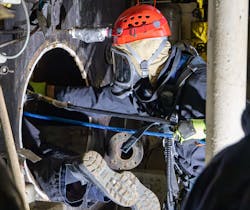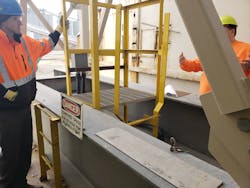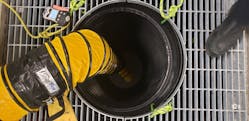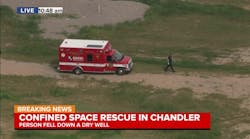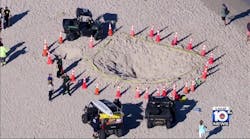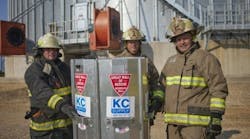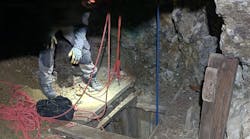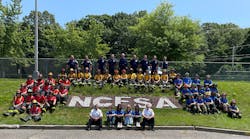Although many fire departments have technical rescue resources available to them either internally or regionally via mutual-aid agreements, chances are that a company that isn’t trained in technical rescue will arrive first at most confined-space incidents. Not only can the actions that are taken by this first-arriving company make or break the entire incident, but they could injure or kill well-intentioned firefighters.
Many responders are familiar with the hierarchy of awareness/operations/technician skills that’s identified in NFPA 1006: Standard for Technical Rescue Personnel Professional Qualifications and how the training for the roles of responders at each level can be incorporated into the overall rescue effort. However, confined-space rescue awareness-level training for non-technical-rescue-team members frequently is boiled down to little more than “stand back and call an adult” from the requirements that are in
Chapter 7 of NFPA 1006. Although such an approach certainly protects non-technical-rescue-team members from becoming additional casualties, it doesn’t recognize the important role that confined-space rescue awareness-level personnel can play in setting up the incident for success—in essence, the first 15 minutes of incident response.
While en route
As in the case of a structure fire, a good size-up of a confined-space incident begins at the time of dispatch.
It’s important to understand that not all confined-space runs are identified properly on the initial dispatch. Whether because of incorrect or vague information that was provided by the caller, overworked dispatchers or other causes, many confined-space incidents are dispatched originally as an injured person, an unconscious person, a person having trouble breathing or industrial accident.
When responders are familiar with the address for a location because of prior runs or preplanning, the first-arriving company should consider the potential for the seemingly “normal” run to occur in a confined space. Although not all confined-space incidents occur at places that commonly are thought of as containing confined spaces, being dispatched to water treatment plants, refineries and other industrial facilities should raise responders’ index of suspicion. Accordingly, the first-due company officer should prompt the dispatcher to obtain additional information from the caller. Some questions that can help with early identification as a confined-space incident include:
• Where is the person located?
• What type of work was being performed?
• What was the person doing when that individual began to feel ill/was injured?
• If there are multiple entrances to the facility, where should the crews respond to?
• Is the person in a confined space?
While en route, responders should take multiple actions to help to set up the incident for success:
• Turn on the four-gas meter/combustible gas meter and perform a fresh air calibration; this step is key for responder safety, because atmospheric hazards might be present inside of the confined space and in spaces and areas that are adjacent to the confined space
• Dress out in turnout gear and SCBA, because hazardous conditions could exist in areas other than where the victim is located
• Review preplan information, if available
• Conduct basic research on the company/facility; a simple internet search of the company/facility name might provide information as to the type(s) of work and processes that occur on site; satellite images of the address might help with identifying potential hazards/confined spaces, such as tanks, silos, rail cars, etc., and potential staging locations should the incident escalateArrival
Whether the incident was dispatched as a confined-space rescue or the first-arriving company suspects that the emergency might be in a confined space, simple steps should be taken on arrival.
Leave the driver with the apparatus while the officer and crew meet the caller and investigate. The location at which you first encounter the caller might be remote from where the incident is or could be immediately adjacent to it. If tasked to remain with the rig, the driver either can move it closer to the incident or reposition it out of the way so that additional resources, such as heavy rescue squads and technical rescue trailers, can bring their specialized equipment as close as possible to the site of the incident.
Speak with the caller and seek out additional knowledgeable personnel, including attendant (if one is present), facility safety personnel, maintenance personnel and management. Their familiarity with the particular hazards, configuration and processes that are associated with the space will prove vital in determining an appropriate course of action.
Ask for the confined-space entry permit, if applicable, to review for particulars.
Ask questions to understand why 9-1-1 was called. How many people are in the space? When was the last time that anyone communicated with them? What type of work was being performed? What is the space used for? What hazards are present in the space?
Assign a member to monitor the atmosphere at all times. The officer should delegate this task, because he or she will be busy gathering information from people who are on scene of the incident.
Atmospheric monitoring
As mentioned previously, the four-gas meter should be turned on and fresh air-calibrated while en route. Carrying out this procedure minimizes the time that’s needed to obtain readings on scene.
On arrival, responders should ensure that the four-gas meter’s peak and minimum values are cleared before the device is used to sample around and adjacent to the confined space. Once the areas around and adjacent to the confined space are cleared, crews should conduct nonentry metering of the confined space.In a confined space that provides vertical access, responders can sample the air remotely either with tubing and a pump or by tying a rope to the four-gas meter and lowering it into the space. Ensure that all levels of the space are monitored, because hazardous gases can be heavier than air, lighter than air or distributed throughout the space. (Ensure that the meter’s peak and minimum values are cleared before conducting remote sampling.)
For a confined space that provides horizontal access, remote metering might require taping the meter to a pike pole.
Ventilation
When atmospheric hazards are present within the space, the first-arriving crew should consider ventilating the space.
Although confined-space blowers and ventilation equipment are preferred, positive pressure fans and smoke ejectors have been utilized successfully to begin ventilation prior to the arrival of technical rescue resources.
Although not the most effective technique, natural ventilation might be an option if multiple access points can be opened.
Prior to beginning ventilation operations, consider where the atmospheric hazards will be exhausted. If the space has a single access point, such as a sewer access, ventilation might displace gases into the area where responders are working. For this reason, continuous atmospheric monitoring of areas that are adjacent to the space must be conducted throughout the entire rescue operation.
Safety and success
Although it’s important for responders to understand that 60 percent of confined-space fatalities are would-be rescuers who entered the space to attempt to rescue the original victim, numerous steps can be taken by the first-arriving company to ensure the safety of responders and to increase the chances for a successful rescue operation.
